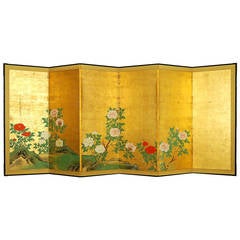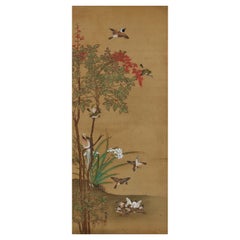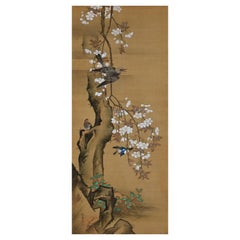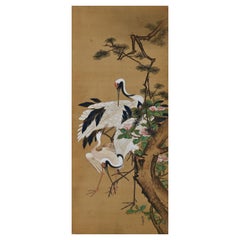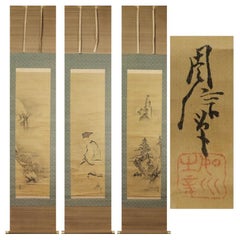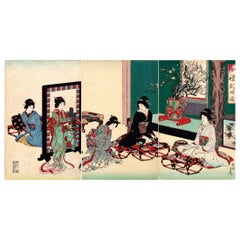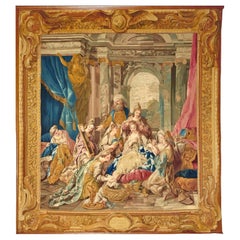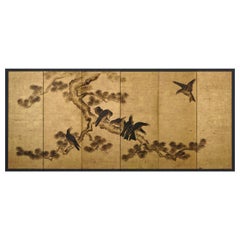Kano Chikanobu
Antique Early 18th Century Japanese Edo Paintings and Screens
Gold Leaf
Antique Early 18th Century Japanese Edo Paintings and Screens
Gold Leaf
Antique Mid-19th Century Asian Edo Paintings and Screens
Silk
Antique Mid-19th Century Asian Edo Paintings and Screens
Silk
Antique Mid-19th Century Asian Edo Paintings and Screens
Silk
Antique Mid-19th Century Asian Edo Paintings and Screens
Silk
Antique Mid-19th Century Asian Edo Paintings and Screens
Silk
Antique Mid-19th Century Asian Edo Paintings and Screens
Silk
Antique Mid-19th Century Asian Edo Paintings and Screens
Silk
Antique 17th Century Edo Paintings
Silk
Antique Late 19th Century Japanese Prints
Paper
People Also Browsed
Antique Early 18th Century French Baroque Western European Rugs
Silk, Wool
Antique Late 19th Century European Moorish Architectural Elements
Wrought Iron
Vintage 1930s Japanese Arms, Armor and Weapons
Fabric, Glass
Antique Late 19th Century Japanese Paintings and Screens
Lacquer, Paper
21st Century and Contemporary Chinese Paintings and Screens
Gold Leaf
Antique 19th Century Japanese Metalwork
Iron
Antique Mid-19th Century English High Victorian Taxidermy
Other
20th Century Japanese Showa Paintings and Screens
Brass
Mid-20th Century Japanese Showa Paintings and Screens
Silk
20th Century Chinese Chinese Export Paintings and Screens
Brass, Gold Leaf
Antique Mid-18th Century Japanese Edo Paintings and Screens
Gold Leaf
21st Century and Contemporary Vietnamese Anglo-Japanese Paintings and Sc...
Wood, Giltwood
21st Century and Contemporary Chinese Paintings and Screens
Gold Leaf
Vintage 1940s Italian Mid-Century Modern Wardrobes and Armoires
Chestnut
Antique Late 19th Century Chinese Chinese Export Decorative Boxes
Mother-of-Pearl, Wood
Antique 19th Century Chinese Beds and Bed Frames
Gold Leaf
Recent Sales
Antique Late 17th Century Japanese Edo Paintings and Screens
Gold Leaf
Kano Chikanobu For Sale on 1stDibs
How Much is a Kano Chikanobu?
A Close Look at edo Furniture
Edo furniture was created during a flourishing time for the decorative arts owing to the stability of the Tokugawa shogunate rule in Japan. Spanning from 1603 to 1867, this era of peace and economic growth supported artistic advancements in lacquer, woodblock printing, porcelain and other artisanal trades. Because the country was largely isolated, there was little outside influence, leading to centuries of exceptional attention to the design of its furnishings and the quality of its traditional arts.
Unlike during the Meiji period that followed, with an increase in domestic and international markets, furniture during the Edo period was predominately commissioned by the ruling class, although people from across social groups benefited from the burgeoning metropolitan hubs for artisanal trades. For instance, Kyoto became a major center for lacquer art. Most furniture pieces were made from wood such as cedar or ash, including the era’s sashimono cabinets, which involved fine joinery and were rooted in the Heian period.
Sashimono cabinets, which were built by master craftsmen in a range of different wood types owing to the various trees that populate Japan, occasionally featured a stack of slender drawers as well as sliding doors. They were popular with everyone from samurai to kabuki actors. Tansu storage chests crafted from wood with metal fittings were also common in Edo-period homes. Some were designed to be easily portable while others were made to double as staircases.
Painted folding screens, called byōbu, were also fashionable, with Japanese artists inspired by nature, literature and scenes of history and daily life to create vivid works. In Buddhist temples and the palatial homes of the aristocratic class, fusuma, or large sliding panels, would sometimes be adorned with gold or silver leaf. These dividers allowed interiors to change throughout the day, closing in small spaces for personal use or reflecting candlelight to illuminate communal spaces after dark.
Find a collection of Edo tables, lighting, decorative objects, wall decorations and more furniture on 1stDibs.
Finding the Right paintings-screens for You
Traditional Asian paintings were often created on scrolls and folding screens. Artisans made screens that could be folded up or spread out by connecting several panels using hinges. Today, antique Asian folding screens and paintings are sophisticated decorative accents that can serve as makeshift partitions to ensure privacy.
The original folding screens were created by Chinese artists. The earliest record of screens comes from the 2nd century B.C., and surviving examples date back to the Ming dynasty. Chinese painting utilizes many of the same tools as calligraphy — these screens were crafted from wood with painted panels featuring striking art or calligraphy that told cultural stories or represented nature and life in the area.
The practice was introduced to Japan, where paintings for screens were made on paper and silk, in the 8th century. These paintings frequently feature subjects such as landscapes, animals, flowers and Buddhist religious themes. Along with screens for tea ceremonies and dance backgrounds, there were screens for use in Shinto and Buddhist temples.
In the 17th century, screens began to be imported to Europe where their popularity grew. Coco Chanel famously collected Coromandel folding screens.
Traditional Asian paintings can make a tasteful addition to any wall, and screens can be used as decoration or, in the case of larger iterations, as an aesthetic way to divide a large room. Browse the selection of antique Asian paintings and screens from a variety of styles and eras on 1stDibs.
